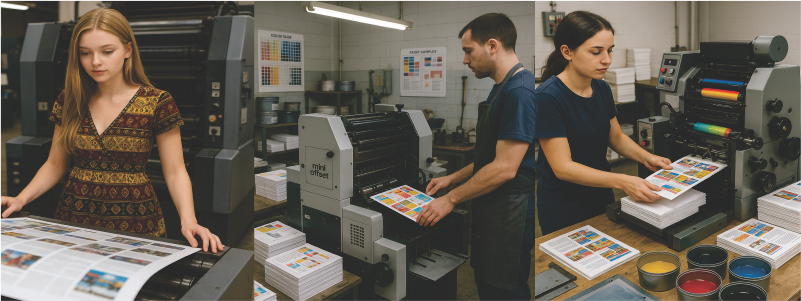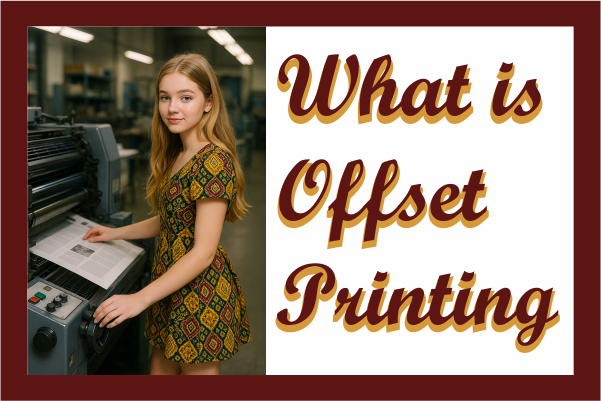Introduction
Printing has long been the backbone of mass communication. From newspapers and magazines to books and packaging, printing technologies have evolved dramatically. Among the various printing methods available today, offset printing stands out as one of the most widely used and reliable processes. In this blog post, we’ll dive deep into what offset printing is, how it works, and why it remains a cornerstone of the printing industry.
Understanding Printing Methods: A Brief Overview
Before diving into printing, it’s important to understand the broader landscape of printing technologies. Common methods include:
- Digital Printing: Quick and cost-effective for short runs.
- Flexographic Printing: Used for packaging and labels.
- Gravure Printing: High-volume printing for long-run jobs.
- Screen Printing: Ideal for textiles and surfaces other than paper.
- Offset Printing: Ideal for high-quality, large-volume print jobs.
Each method has its advantages, but printing remains a go-to for its superior print quality and cost-efficiency at scale.
What is Offset Printing ?
Offset printing, also known as offset lithography, is a printing technique where the inked image is transferred (or “offset”) from a plate to a rubber blanket, and then onto the final printing surface typically paper.
“Offset” is the name for the process of transferring images that happens indirectly, as opposed to direct methods like digital printing.
History and Evolution of Offset Printing
Alois Senefelder invented lithography in the late 1700s, which is where this approach comes from. In the early 1900s, the first signs of modern printing started to appear.
- 1903: Ira Washington Rubel discovered the benefits of transferring the image via a rubber blanket, laying the groundwork for offset printing.
- 1920s–1950s: Offset became the dominant method for commercial printing.
- Today: Despite digital alternatives, offset printing remains prevalent for high-volume and high-quality needs.
How Offset Printing Works
Prepress Process
This includes designing, preparing digital files, and converting them into printing plates using computer-to-plate (CTP) technology.
Plate Creation
The CMYK system, which stands for Cyan, Magenta, Yellow, and Black, requires the creation of separate printing plates for each of the eight colours. The image is burned onto metal plates.
Ink and Water Balance
Lithography is based on the repulsion of oil and water. The plate is dampened with water, which adheres to the non-image areas, and ink sticks only to the image areas.
Printing on Substrate
The picture is first moved from the plate to a rubber blanket, and then it is put on the final material, like paper. This three-step process ensures precision and high print quality.
Types of Offset Printing
Sheet-fed Offset Printing
Prints on individual sheets of paper. It’s a great choice for making high-quality items like books, posters, and brochures.
Web Offset Printing
Uses a continuous roll of paper. Common for high-volume outputs like newspapers and magazines.
- Coldset Web Offset: Used for newspapers, dries by absorption.
- Heatset Web Offset: Used for glossy materials, dries with heat.
Advantages of Printing
- High Image Quality: Sharp, clean images with rich detail.
- Cost-Effective at Scale: Cheaper per unit with large print runs.
- Fast Production Speed: Especially for large-volume jobs.
- Consistency: Reproducible results throughout the entire print run.
- Works with a lot of different materials: You may print on paper, plastic, and cardboard, among other things.
Limitations of Printing
- High Initial Setup Cost: Not economical for short runs.
- Longer Turnaround Time: Due to setup and plate preparation.
- Not Ideal for Variable Data: Unlike digital printing, every copy is identical.
Offset Printing vs Digital Printing
| Feature | Offset Printing | Digital Printing |
| Setup Cost | High | Low |
| Unit Cost | Low (for high volume) | Higher |
| Turnaround Time | Longer | Faster |
| Quality | Very high | Good (sometimes comparable) |
| Variable Data | Not ideal | Perfect for personalization |
| Print Volume | Best for large runs | Best for short runs |
Applications of Printing
Offset printing is used in numerous industries for:
- Books and Novels
- Newspapers and Magazines
- Posters and Catalogs
- Brochures and Flyers
- Packaging and Labels
- Business Cards and Stationery
Key Components and Machinery Used
Printing Plates
Usually made from aluminum, these hold the image to be printed.
Blanket Cylinder
The rubber blanket transfers the image from the plate to the paper.
Impression Cylinder
Pushes the paper against the blanket cylinder to receive the image.
Ink and Dampening Systems
These control the distribution of ink and water to ensure quality.
Feed and Delivery Units
These handle paper feeding and output collection efficiently.

The Role of Printing in the Modern Print Industry
Offset printing is still important for making a lot of copies with exact colour reproduction, even though digital printing is getting more popular. Many publishers, advertising agencies, and packaging companies rely on offset for quality and economy.
Cost Analysis: When to Choose Offset
Offset printing becomes cost-effective when:
- The print quantity is 500+ copies.
- The job requires exact color matching.
- The quality cannot be compromised.
- You’re printing multiple copies of the same content (no personalization).
For example, a run of 10,000 brochures would be significantly cheaper per unit with offset compared to digital.
Environmental Considerations in Offset Printing
Offset printing involves chemicals and resource use, but modern advancements have made it more eco-friendly:
- Soy-based inks and low-VOC solvents are widely adopted.
- Recycled paper and FSC-certified substrates help reduce impact.
- Computer-to-plate (CTP) systems reduce waste.
- Efficient presses reduce water and electricity use.
However, digital printing may still have an edge in sustainability for ultra-short runs due to less material waste.
Future of Offset Printing
Even if digital printing has become increasingly popular, offset printing continues to play an important role in the marketplace.
- Hybrid printing systems are combining offset and digital capabilities.
- Automation and AI are streamlining plate changes and ink calibration.
- Eco-friendly advancements are keeping offset sustainable.
- Global demand for packaging and publishing keeps offset in demand.
Offset printing is evolving, not disappearing.
Conclusion
Offset printing continues to play a vital role in the print industry thanks to its superior image quality, cost-efficiency for large runs, and versatility in materials. When it comes to those that require output on a huge scale while maintaining an extraordinary level of quality, offset printing remains the favoured option.
Whether you’re a print shop owner, a graphic designer, or a student in a DTP course, understanding offset printing opens the door to producing professional, market-ready print products. As printing technologies advance, offset printing is adapting and thriving-proving its enduring value in both traditional and modern applications.

